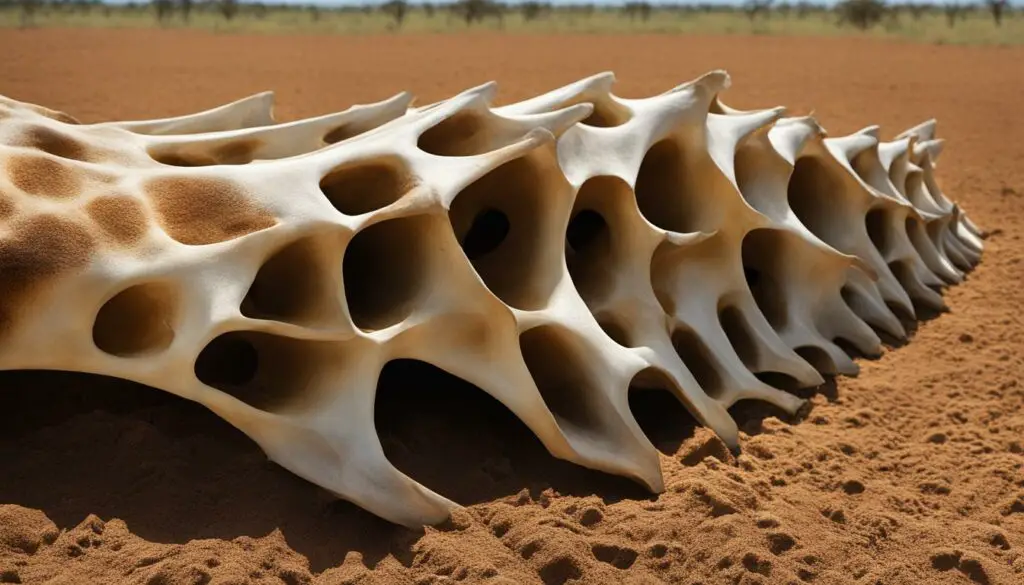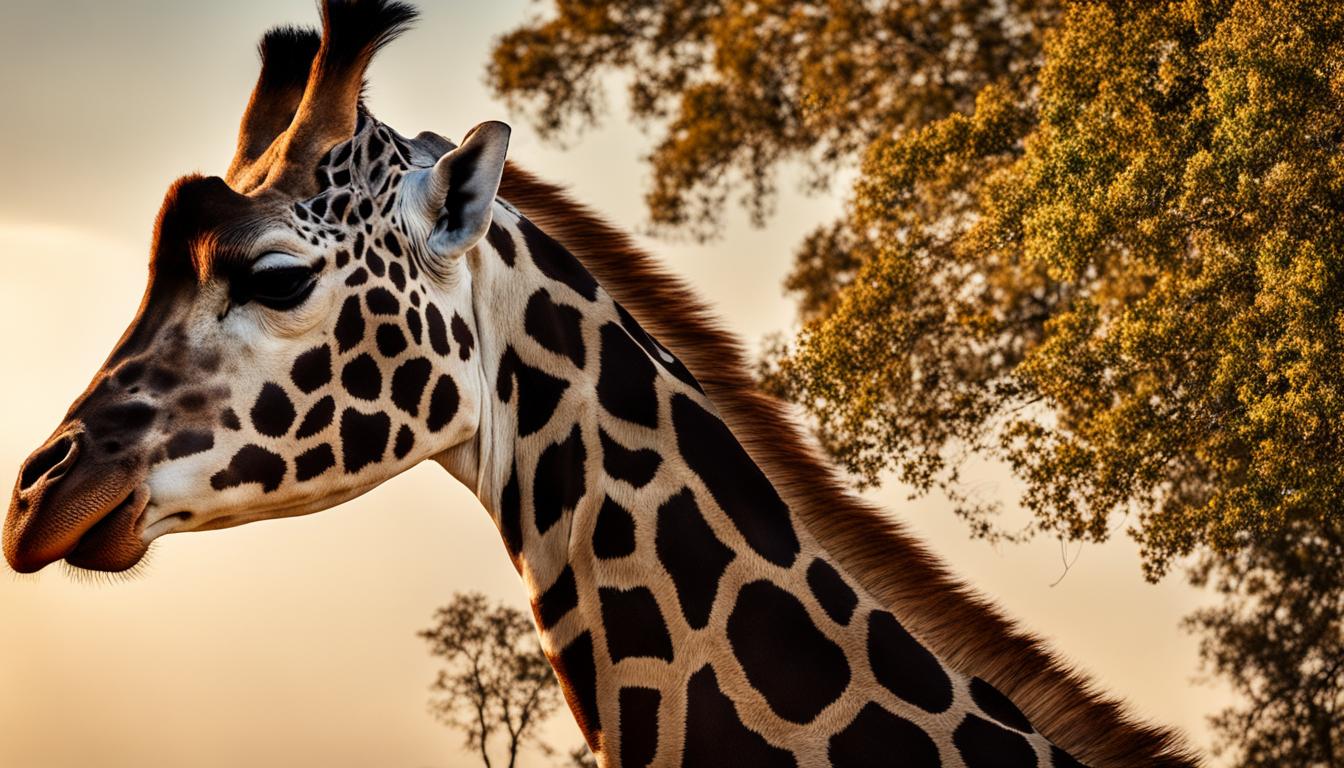Giraffes are extraordinary creatures with a unique and fascinating body structure. One of their most remarkable features is their long neck, which can reach up to 6.5 feet in length. Just like humans, giraffes have seven vertebrae in their necks, allowing them to reach tall trees and access food that other animals cannot. This distinct adaptation sets them apart from any other animal in the world.
But the giraffe’s body structure goes beyond its elongated neck. They have a specialized skeletal system, muscular system, and bone structure that support their impressive height and weight. Their legs are long, thin, and incredibly powerful, enabling them to run at speeds of up to 37 mph. They also have unique external features like humps, ossicones (knobs on their heads), and stunning coat patterns.
Understanding the anatomy and body structure of giraffes helps us appreciate the magnificence and complexity of these incredible animals. From their cardiovascular system to their respiratory system, every aspect of a giraffe’s body is designed for their remarkable high-rise lifestyle.
The Adaptations of a Giraffe’s Body
Giraffes have evolved remarkable adaptations to thrive in their unique environment. Their body is specifically designed to support their long necks, high reach, and overall physical needs. Let’s explore some of the key adaptations of a giraffe’s body.
Giraffe Cardiovascular System
The cardiovascular system of giraffes is a marvel of adaptation. Their hearts are relatively small compared to their size, but they have thick walls and a self-regulating system to ensure optimal blood circulation. This adaptation is necessary because the giraffe’s heart must pump blood up to its brain, which is located about 6 feet above its heart. To compensate for the long distance and maintain steady blood flow, the giraffe’s cardiovascular system has specialized valves and blood vessels that prevent backflow and regulate blood pressure. This unique adaptation allows giraffes to withstand the physical demands of their towering stature.
Giraffe Respiratory System
The respiratory system of giraffes is another remarkable adaptation. To compensate for the challenges posed by their long necks, giraffes have a 12-foot-long trachea and oversized lungs. These adaptations enable efficient oxygen intake and carbon dioxide elimination, ensuring that giraffes can sustain their high-rise lifestyle. The long trachea helps to maintain a steady airflow, reducing the risk of respiratory issues, while the larger lungs provide an ample oxygen supply. These adaptations allow giraffes to breathe easily and maintain their physical exertion levels, even with their lengthy necks.
Table: Giraffe Adaptations
| Adaptation | Description |
|---|---|
| Cardiovascular System | Giraffes have a unique cardiovascular system with specialized valves and blood vessels that allow for optimal blood circulation despite the long distance between the heart and brain. |
| Respiratory System | Giraffes have a 12-foot-long trachea and oversized lungs, enabling efficient oxygen intake and carbon dioxide elimination to sustain their high-rise lifestyle. |
| Muscular System | Giraffes have powerful muscles in their necks, legs, and bodies, enabling them to reach high branches, run at impressive speeds, and support their massive weight. |
Giraffes have also developed a muscular system that supports their unique physical abilities. Their neck muscles are exceptionally strong, allowing them to reach high branches and obtain food that other herbivores cannot access. Additionally, their legs have powerful muscles, enabling giraffes to run at speeds of up to 37 mph for short distances. These adaptations to their muscular system provide giraffes with both feeding and defense advantages, making them well-suited to their environment.
The adaptations of a giraffe’s body, including their cardiovascular and respiratory systems, as well as their muscular system, highlight the incredible ways in which these animals have evolved to thrive. These adaptations enable giraffes to reach extraordinary heights, navigate their surroundings, and fulfill their unique ecological roles. The next section will explore the external features of giraffes, providing further insights into their remarkable anatomy and adaptations.
The External Features of a Giraffe
Giraffes possess a range of external features that contribute to their unique body structure and enable them to thrive in their natural habitat. Their skeletal system is specifically designed to support their remarkable height, weight, and agility. The long and slender legs of giraffes provide the necessary stability and power for them to run at impressive speeds of up to 37 mph, making them one of the fastest land mammals. As a result, their limb structure plays a crucial role in their ability to navigate their environment.
The muscular system of giraffes is equally remarkable. The powerful muscles in their necks allow them to extend their heads and reach tall trees for food. Additionally, these muscles lend support and stability to the neck by counterbalancing the weight and preventing strain. Giraffes also have prominent ossicones on their heads, which are bony knobs covered in skin and hair. These ossicones serve as unique features that distinguish males and females, and they play a role in fighting and courtship rituals.
A Comparative Look at the Giraffe’s Skeletal and Muscular System
In order to understand the influence of the skeletal and muscular systems on a giraffe’s body structure, let’s take a closer look at the comparison below:
| Giraffe | Human | |
|---|---|---|
| Skeletal System | Specialized to support height and weight, with elongated legs and a long and flexible neck. | Vertical posture, shorter and more compact bones. |
| Muscular System | Powerful neck muscles for extending the head and reaching tall trees for food. | Less pronounced neck muscles due to a shorter neck. |
As shown in the comparison above, the giraffe’s skeletal system and muscular system are specifically adapted to its unique body structure and lifestyle, allowing it to excel in its environment.

Size and Weight of Giraffes
Giraffes are renowned for their impressive size and stature, making them the tallest land animals on the planet. With heights ranging from 13 to 19 feet, these majestic creatures truly stand out in the animal kingdom. One of the most striking features of a giraffe is its long neck, which can measure up to 6.5 feet in length. This neck is composed of seven vertebrae, just like humans, and is supported by powerful muscles that allow the giraffe to reach tall trees and obtain food.
Male giraffes tend to be larger than females in both height and weight. On average, male giraffes weigh around 2,600 pounds, while females have an average weight of 1,800 pounds. These weights are supported by the giraffe’s specialized bone structure and strong muscular system. In addition to their impressive body weight, giraffes also possess the longest tail of any land mammal, measuring from 32 to 40 inches. This tail serves a variety of purposes, including balance, communication, and swatting away insects.
To gain a better understanding of the size and weight of giraffes, let’s take a look at the following table:
| Giraffe | Height (feet) | Weight (pounds) |
|---|---|---|
| Male Giraffe | 13-19 | 2,600 |
| Female Giraffe | 13-19 | 1,800 |
As seen in the table above, male giraffes are not only taller but also significantly heavier than their female counterparts.
Conclusion
The anatomy and body structure of a giraffe are truly remarkable. Their unique features, such as the long neck and specialized skeletal system, make them stand out in the animal kingdom. Giraffes have seven vertebrae in their necks, allowing them to reach heights of up to 6.5 feet.
But it’s not just their body structure that sets them apart. Giraffes have adaptations that help them thrive in their environment. Their cardiovascular system ensures optimal blood circulation despite the long distance between their heart and brain. Additionally, their respiratory system compensates for the challenges posed by their long necks, with oversized lungs and a 12-foot trachea.
From their muscular system supporting their powerful legs to their bone structure and distinct features like ossicones on their heads, giraffes are truly fascinating creatures. Their size and weight are supported by their specialized body design. And, of course, their coat patterns and skin coloration provide both camouflage and heat regulation.
Understanding the body structure and adaptations of giraffes helps us appreciate the complexity of these incredible animals. Their high-rise lifestyle is not just a result of their long necks but a combination of various anatomical features working together. Giraffes truly are a marvel of the animal kingdom.
Does the Anatomy of a Giraffe Affect the Birthing Process and Raising Calves?
The anatomy of a giraffe plays a significant role in the giraffe birthing and calf rearing process. With their long necks and legs, birthing can be a challenging task. However, the tall height of giraffes aids in protecting their young from predators. Additionally, their unique physiology allows calves to stand and walk within hours of birth, ensuring a quicker adaptation to their environment.
FAQ
What is the anatomy and body structure of a giraffe?
Giraffes have a unique and fascinating body structure. Their most distinctive feature is their long neck, which is made up of seven vertebrae, just like humans. Their necks can reach up to 6.5 feet in length and are supported by powerful muscles. Giraffes also have a specialized skeletal system, muscular system, and bone structure that support their height and weight. Other notable features include their humps, tongue, ossicones (knobs on their heads), and spots.
What are the adaptations of a giraffe’s body?
Giraffes have a cardiovascular system that allows them to maintain blood pressure and flow despite the long distance between their heart and brain. Their heart is relatively small but has thick walls and a self-regulating system to ensure optimal blood circulation. Giraffes also have a respiratory system that compensates for the challenges of their long neck. Additionally, their skeletal system is designed to support their height and weight while allowing for agility and speed.
What are the external features of a giraffe?
Giraffes have long, thin, and powerful legs that enable them to run at speeds of up to 37 mph. They have hoofed feet that protect them from harmful substances on the ground. Their distinct bone structure includes ossicones on their heads, which serve as unique features for both males and females. The giraffe’s coat patterns and skin coloration provide camouflage and heat regulation.
How big are giraffes?
Giraffes are the tallest land animals, with heights ranging from 13 to 19 feet. Male giraffes tend to be larger than females, with average weights of 2,600 pounds compared to females’ average weight of 1,800 pounds. The weight of a giraffe’s body is supported by its specialized bone structure and strong muscular system. Additionally, their tail is the longest of all land mammals, measuring from 32 to 40 inches.







